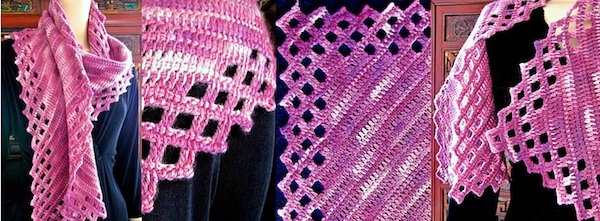This is the first of 3 blog posts on the release of a new Tunisian crochet pattern. The 2nd is here and the third is here.
I used no Tunisian crochet stitches for the swatch on the left only.
Instead, I used single crochet, double crochets, and chains. (US abbreviations: sc, dc, and ch. Outside of the US: dc, tr, ch). The chs and dcs create lacy open spaces in the style of filet crochet. I alternated each filet row with a row of sc. Not traditional for filet crochet, but it does follow filet logic. (This is one reason I wanted to swatch it; see this newsletter issue about a similar experiment.)

The sc rows give the spaces thicker top and bottom “walls” around the spaces. This matches the thicker side “walls” created by the dc pairs.
This stitch pattern is converted from the Warm Aeroette Scarf on the right, which is 100% Tunisian crochet stitches. I was curious to see how much these two would differ in looks, surface texture, and drape.
Single Crochets versus Tunisian Crochet Stitches
The first thing I notice about the left swatch is the single crochets. Specifically, the backs of them. They’re raised, bumpy, and have a distinctive look. To me they emphasize a horizontal grain of the left swatch.
Unlike the rows of Tunisian crochet stitches on the right, I turned after every row of the left swatch. We’re looking at the right side of a dc row alternated with a wrong side of a sc row. The bumpy sc backs also cause the dc rows to recede a bit. This adds to the effect of the sc rows standing out, almost ridge-like.
This effect is mostly absent from the Tunisian swatch on the right. Its surface is uniformly flatter. Tunisian crochet stitches do have their own horizontal texture. They get it from the return passes – that second part of a complete Tunisian row when you crochet the loops off of the hook. In this pattern, the return pass textures are no more raised than the vertical stitch textures created during the forward passes.
Differences I’m Not Seeing
I expected to see a difference in how the yarn’s color changes look, but I don’t really. Maybe the swatch on the left needs to be much bigger. I also expected the Tunisian one to drape more. Perhaps it doesn’t because this is wool, and the hook size is smaller than I usually use for lacy Tunisian crochet stitches. I used a G-7 (4.5 mm) hook. For the non-Tunisian swatch I used a G-6 (4 mm) crochet hook.
The Warm Aeroette Scarf on the right is the next pattern I’ll be adding to the shop. I’ll announce it in my newsletter. You can also track its project page in Ravelry.

